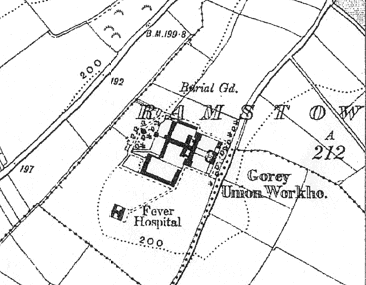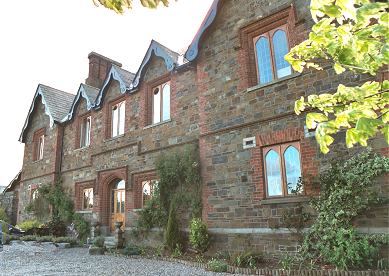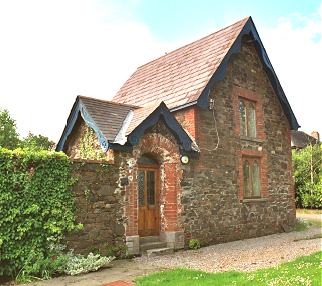Gorey, Co. Wexford
Gorey Poor Law Union was formally declared on the 14th December 1839 and covered an area of 189 square miles. Its operation was overseen by an elected Board of Guardians, 24 in number, representing its 10 electoral divisions as listed below (figures in brackets indicate numbers of Guardians if more than one):
Co. Wexford: Ballycaneu (2), Ballyellis (2), Camolin (2), Coolgraney (3), Courtown (2), Gorey (4), Monomolin (3), Rosmanogue (2), Wells (2), Wingfield (2).
The Board also included 8 ex-officio Guardians, making a total of 32. The Guardians met each week on Saturday.
The population falling within the Union at the 1831 census had been 36,083 with divisions ranging in size from Ballyellis (population 2,151) to Gorey (7,199).
The new Gorey Union workhouse was erected in 1840-1 on a seven-acre site to the south-west of Gorey. Designed by the Poor Law Commissioners' architect George Wilkinson, the building was based on one of his standard plans to accommodate 500 inmates. Its construction cost £5,675 plus £1,025 for fittings etc. The workhouse was declared fit for the reception of paupers on 21st December 1841, and received its first admissions on 18th February 1842. The workhouse site location and layout are shown on the 1907 OS map below.

Gorey workhouse site, 1907.
The buildings followed Wilkinson's standard layout with an entrance and administrative block at the east containing a porter's room and waiting room with the Guardians' board room on the first floor above.

Gorey entrance block from the east, 2002
© Peter Higginbotham.
A small detached cottage stood to the north of the administrative block, perhaps providing accommodation for the Master.

Gorey workhouse cottage from the east, 2002
© Peter Higginbotham.
The main accommodation block to the rear contained male accommodation at one side and female the other. At the rear, utility rooms such as bakehouse and washhouse were connected through to the infirmary via a central spine containing the chapel and dining-hall.
During the famine in the mid-1840s, sleeping galleries were erected to accommodate an additional 80 inmates. The dining-hall was converted into dormitories for a further 80. A house was hired for use as a 50-bed fever hospital, with fever sheds and a fever hospital later being erected at the south of the workhouse. A burial ground stood to the north of the site.
The workhouse site was later occupied by the Gorey Leather Company. Nearly all the workhouse buildings have now been demolished. The surviving administrative block and cottage have been converted to residential use.
Records
Note: many repositories impose a closure period of up to 100 years for records identifying individuals. Before travelling a long distance, always check that the records you want to consult will be available.
- Wexford County Archive Service, 6A Ardcavan Business Park, Ardcavan, Co. Wexford. Visitors by prior appointment only.
Bibliography
- Historic Gorey — The Famine Years by Michael Fitzpatrick
- The Workhouses of Ireland by John O'Connor (Anvil Books, 1995)
Links
- None.
Unless otherwise indicated, this page () is copyright Peter Higginbotham. Contents may not be reproduced without permission.


